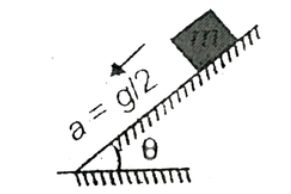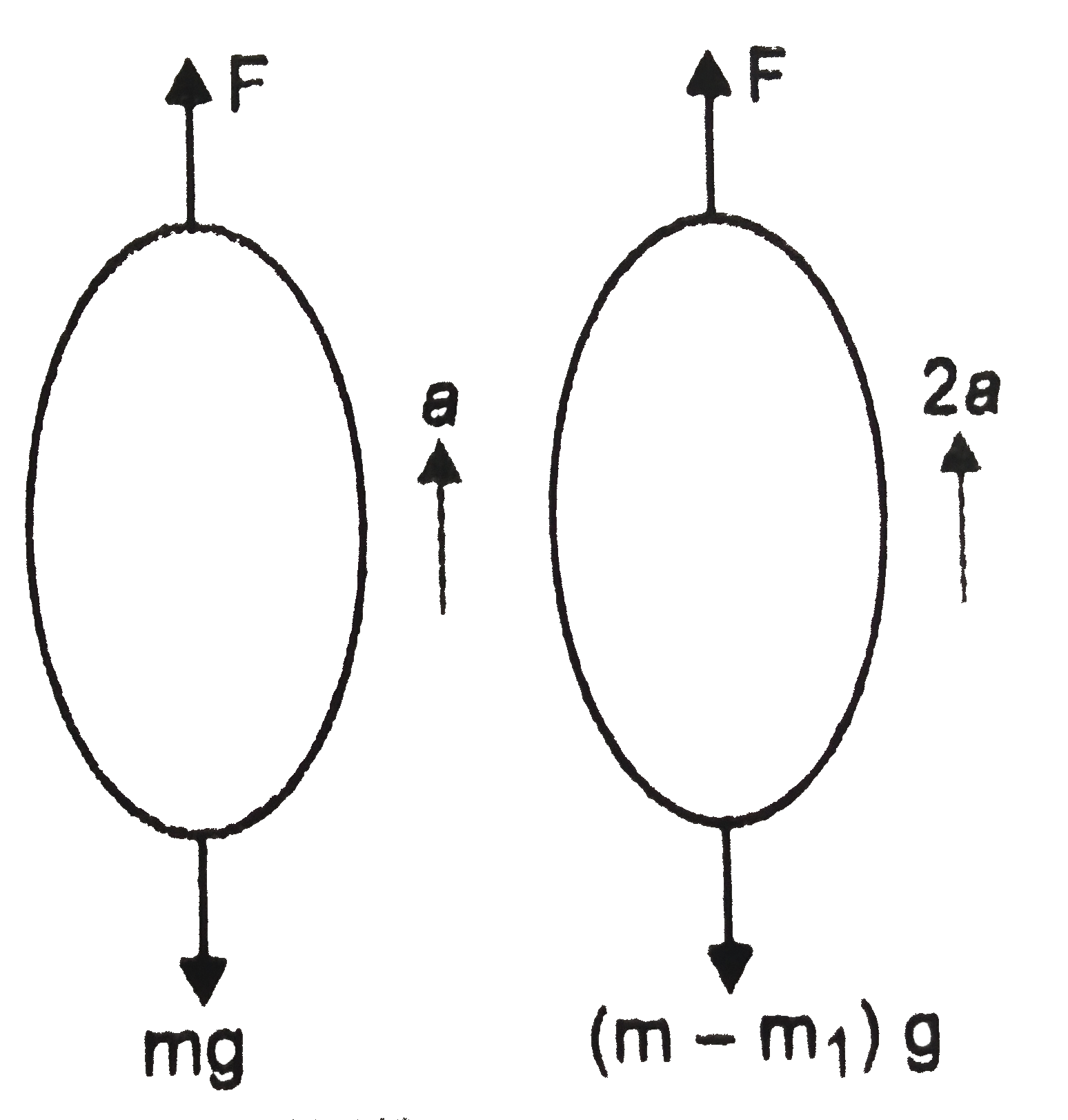A balloon with mass m is descending down with an acceleration a (wherea<g) . How much mass should be removed from it so that it starts moving up with an acceleration a?
2M(g)a
M(g+a)g
Mgg+a
2Mag+a
The correct Answer is:D
To solve the problem of how much mass should be removed from a descending balloon so that it starts moving upwards with a specified acceleration, we can follow these steps:
Step 1: Analyze the Forces Acting on the Balloon
The balloon has a mass m and is descending with an acceleration a, where a<g (g is the acceleration due to gravity). The forces acting on the balloon are:
- The weight of the balloon, which is W=mg (downward).
- The buoyant force F (upward).
Step 2: Set Up the Equation for Downward Motion
Since the balloon is descending with an acceleration a, we can apply Newton's second law:
\(
mg - F = ma
\)
Rearranging gives us:
\(
F = mg - ma
\)
This is our Equation 1.
Step 3: Analyze the Forces When Mass is Removed
Let’s denote the mass that needs to be removed as m'. After removing this mass, the new mass of the balloon becomes m−m'. We want the balloon to ascend with the same acceleration a.
Step 4: Set Up the Equation for Upward Motion
For the balloon to move upwards with an acceleration a, we can write:
\(
F - (m - m')g = (m - m')a
\)
Rearranging gives us:
\(
F = (m - m')g + (m - m')a
\)
This is our Equation 2.
Step 5: Substitute Equation 1 into Equation 2
From Equation 1, we know that:
\(
F = mg - ma
\)
Now we substitute this expression for F into Equation 2:
\(
mg - ma = (m - m')g + (m - m')a
\)
Step 6: Expand and Rearrange the Equation
Expanding the right side:
\(
mg - ma = mg - m'g + ma - m'a
\)
Now, we can cancel mg from both sides:
\(
-ma = -m'g + ma - m'a
\)
Rearranging gives:
\(
-ma - ma = -m'g - m'a
\)
This simplifies to:
\(
-2ma = -m'g - m'a
\)
Step 7: Factor Out m'
Rearranging gives:
\(
2ma = m'(g + a)
\)
Now, we can solve for m':
\(
m' = \frac{2ma}{g + a}
\)
Conclusion
The mass that should be removed from the balloon so that it starts moving upwards with an acceleration a is:
\(
m' = \frac{2ma}{g + a}
\)
Final Answer
The correct option is Option 4: \( m' = \frac{2ma}{g + a} \).
---
The balloon has a mass m and is descending with an acceleration a, where a<g (g is the acceleration due to gravity). The forces acting on the balloon are:
- The weight of the balloon, which is W=mg (downward).
- The buoyant force F (upward).
Since the balloon is descending with an acceleration a, we can apply Newton's second law:
\(
mg - F = ma
\)
Rearranging gives us:
\(
F = mg - ma
\)
This is our Equation 1.
Let’s denote the mass that needs to be removed as m'. After removing this mass, the new mass of the balloon becomes m−m'. We want the balloon to ascend with the same acceleration a.
For the balloon to move upwards with an acceleration a, we can write:
\(
F - (m - m')g = (m - m')a
\)
Rearranging gives us:
\(
F = (m - m')g + (m - m')a
\)
This is our Equation 2.
From Equation 1, we know that:
\(
F = mg - ma
\)
Now we substitute this expression for F into Equation 2:
\(
mg - ma = (m - m')g + (m - m')a
\)
Expanding the right side:
\(
mg - ma = mg - m'g + ma - m'a
\)
Now, we can cancel mg from both sides:
\(
-ma = -m'g + ma - m'a
\)
Rearranging gives:
\(
-ma - ma = -m'g - m'a
\)
This simplifies to:
\(
-2ma = -m'g - m'a
\)
Rearranging gives:
\(
2ma = m'(g + a)
\)
Now, we can solve for m':
\(
m' = \frac{2ma}{g + a}
\)
The mass that should be removed from the balloon so that it starts moving upwards with an acceleration a is:
\(
m' = \frac{2ma}{g + a}
\)
The correct option is Option 4: \( m' = \frac{2ma}{g + a} \).
Topper's Solved these Questions
- PROPERTIES OF MATTERBOOK - DC PANDEY ENGLISHCHAPTER - PROPERTIES OF MATTEREXERCISE - More than one option is correct
21 Videos
- PROPERTIES OF MATTERBOOK - DC PANDEY ENGLISHCHAPTER - PROPERTIES OF MATTEREXERCISE - Comprehension
32 Videos
- PROPERTIES OF MATTERBOOK - DC PANDEY ENGLISHCHAPTER - PROPERTIES OF MATTEREXERCISE - Integer
8 Videos
- PROJECTILE MOTIONBOOK - DC PANDEY ENGLISHCHAPTER - PROJECTILE MOTIONEXERCISE - Level - 2 Subjective
10 Videos
- RAY OPTICSBOOK - DC PANDEY ENGLISHCHAPTER - RAY OPTICSEXERCISE - Integer type q.
14 Videos
Similar Questions
A balloon of mass m is descending down with an acceleration How much mass should be g2 removed from it so that it starts moving up with same acceleration?
View SolutionA balloon with its contents weighing 160 N is moving down with an acceleration of g/2 ms−2 . The mass to be removed from it so that the balloon moves up with an acceleration of-g/3 ms−2 is
View SolutionA balloons of mass M is descending at a constant acceleration α. When a mass m is released from the balloon, it starts rising. With the same acceleration α. Assuming that its volumes does not change, what is the valule of m?
View SolutionA balloons of mass M is descending at a constant acceleration α. When a mass m is released from the balloon, it starts rising. With the same acceleration α. Assuming that its volumes does not change, what is the valule of m?
View SolutionA block of mass 2 kg rests on an inclined plane which makes an angle of 30∘ with the horizontal. The coefficient of friction between the block and the surface is √3/2. (i) What force should be applied on the block so that it moves down without any acceleration ? (ii) What force should be applied on the block so that it moves up without any acceleration ? (iii) Calculate the ratio of the powers in the above two cases if the block moves with uniform speed in both the cases.
View SolutionA block of mass m slides down a rough inclined plane with an acceleration g2

View SolutionThe force of buoyancy exerted by the atmosphere on a balloon is B in the upward direction and remains constant. The force of air resistance on the balloon acts opposite to the direction of velocity and is proportional to it. The balloon carries a mass M and is found to fall down near the earth's surface with a constant velocity v. How uch mass hsould be removed from teh balloon so that it may rise with a constant velocity v?
View SolutionA ballon of mass m is rising up with an acceleration a show that the fraction og weight of balloon that must be detached in order to double its acceleration , assuming the upthrust of air to remain the same

View SolutionA body starts from rest and then moves with uniform acceleration. Then.
View SolutionA balloon of mass M descends with an acceleration a0. The mass that must be thrown out in order to give the balloon an equal upwards acceleration will be
View Solution
